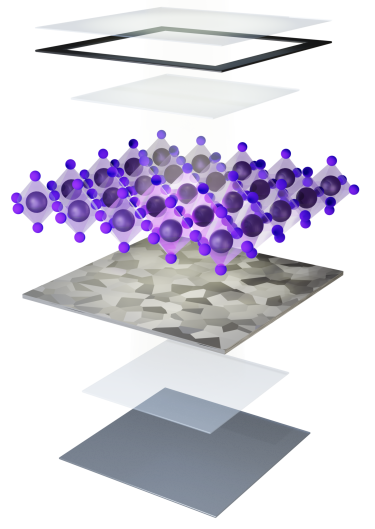
Principals
Seth Marder; Mike McGehee; Michael Toney

Funding
Department of Energy (DOE) Solar Energy Technology Office (SETO)

Collaboration + support
CU Boulder’s Renewable and Sustainable Energy Institute (RASEI); Joseph Luther; academic collaborators Arizona State University, Northwestern University and University of California Merced; industrial collaborators Beyond Silicon, Swift Solar and Tandem PV; National Renewable Energy Laboratory (NREL)
Learn more about this topic:
 National CU Boulder-led consortium aims to enable the commercialization of perovskite-silicon tandem solar cells
National CU Boulder-led consortium aims to enable the commercialization of perovskite-silicon tandem solar cells
The U.S. Department of Energy Solar Energy Technologies Office (SETO) has funded a major new research consortium at the Renewable and Sustainable Energy Institute (RASEI) at CU Boulder. Tandems for Efficient and Advanced Modules using Ultrastable Perovskites, or TEAMUP, is poised to enhance the resilience of tandem perovskite-silicon solar modules, enabling scaling and manufacturing, and ultimately ushering in the next generation of more affordable and efficient solar energy.
Nine million dollars in funding over three years will support collaborative research across four academic institutions (Arizona State University, CU Boulder, Northwestern University and University of California Merced), three industrial companies (Beyond Silicon, Swift Solar and Tandem PV) and one national laboratory (National Renewable Energy Laboratory, or NREL). The consortium will bring together expertise in: manufacturing perovskites, a cutting-edge material for harvesting solar energy; placing perovskite materials into electronic devices to harvest the electricity generated; and layering the new technology into existing silicon-based solar panels to rapidly integrate perovskite technology into current solar infrastructure.
Solar panels must perform in unforgiving environments, including a wide range of temperatures and weather conditions. TEAMUP, led by chemical and biological engineering Professor Mike McGehee, will focus on improving the durability of these materials to increase the stability and efficiency of the solar cells, ultimately helping drive down costs.
“People choose the option that saves them money, so by making solar cells less expensive, it’s really going to help the environment,” said McGehee.
First introduced in the 1950s, modern solar panels use silicon as the semiconductor. However, manufacturing silicon is expensive and energy intensive, which has driven many researchers to focus on replacing silicon with solar panels made completely from perovskite materials. Unfortunately, these next-generation panels are many years away. Tandem perovskite-silicon solar cells, which use a layer of perovskite placed on top of existing silicon-based technology, are more efficient and could enable panels to produce 50% more power. The opportunity to integrate perovskite with today’s silicon cells and modules, and the potential to reach gigawatt production milestones on a timescale attractive to investors and manufacturers for commercialization and deployment, is driving interest in this area.
Two approaches have emerged for combining the perovskite and silicon technologies. The ‘monolithic’ approach directly combines the perovskite and silicon together into a single-piece solar module. In the alternative ‘mechanically stacked’ approach, separate pieces of perovskite and silicon materials are stacked, with the perovskite layer on top.
Which approach to pursue? Instead of focusing exclusively on a single approach, TEAMUP has brought together experts in both approaches to work together and learn from each other. Creating a research ecosystem that fosters creative collaboration above competition is central to this consortium.
“We have an extraordinary team who bring many different types of expertise and I look forward to seeing what we can accomplish,” said McGehee.
“Tandem PV and Swift Solar have long sought to work directly together and with the broader U.S. research community on common research topics that can be solved more quickly as a group. We are excited by the opportunity to work on the same team and not as competitors,” said Colin Bailie, founder and CEO of Tandem PV.
Solving these stability issues and making this new technology durable enough to stand up to the rigors of life in the sun could have a significant impact on the broader economy.
“Perovskite-silicon tandems represent not only the opportunity to make solar more affordable for more communities in the U.S., but also a unique opportunity to return the U.S. to a position of leadership in solar manufacturing and develop a domestic manufacturing base around this new technology,” said Bailie.
Tomas Leijtens, cofounder and chief technology officer for Swift Solar, agreed. “We’re excited to work with this diverse team to tackle the most pressing stability and performance challenges as we scale up perovskite solar technology. This consortium should help accelerate perovskite tandem commercialization in the U.S.”
Images: Mike McGehee and Tomas Leitjens working on solar cells; a stacked illustration of how the perovskite layer (purple layer) will be laid on top of the existing silicon technology (grey-scaled layer), representing both the monolithic and mechanically stacked configurations. Images by: Daniel Morton.
